Once having made the decision to reduce waste and cut single use plastic from your life, the obvious will suddenly dawn on you that “oh my gosh, bread is in a plastic bag!” For me the realisation provoked a state of panic as I imagined myself slaving away in the kitchen baking loaf after loaf to keep up with the family’s demand. How would I have time to do this? Then I remembered that my mum had a bread maker that she didn’t use so I promptly payed her a visit and acquired a bread maker (thanks mum).
Problem solved right? Not quite. Breadmakers require ingredients. Ingredients come in packages at the local supermarket – at least that was the case until I found a store that sold bulk flour.
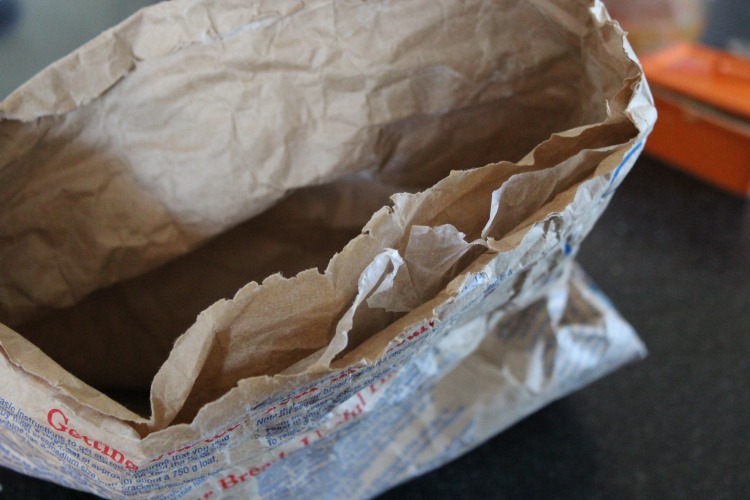
The problem is, there is nearly always a hidden plastic bag within the packaging. When I first bought a large ‘paper’ bag of bread mix I discovered a plastic bag sandwiched between two layers of paper! I did eventually find an all paper bag of bread mix but then I had to buy the yeast. Yeast, as far as I know is only packaged in foil plastic laminates or other unrecyclable packaging. Oh well can’t win them all. Nevertheless, I made significant reductions in the amount of waste generated from our consumption of bread.
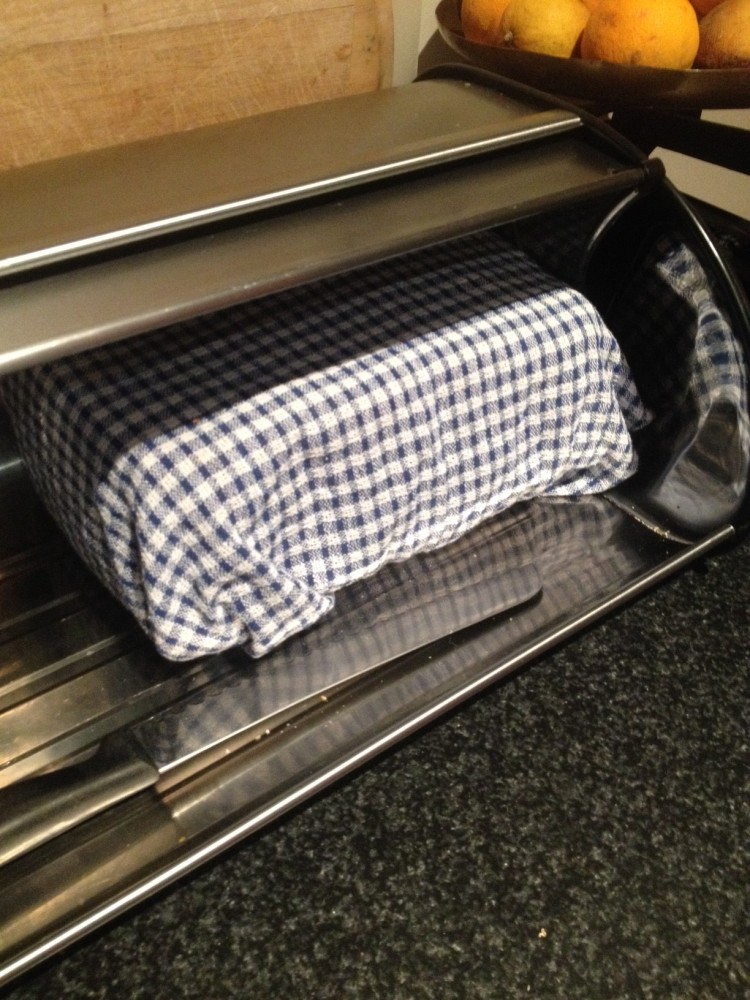
The breadmaker got a three month work out, with each loaf made wrapped in a clean tea towel and placed in the bread tin. Loaves were eaten within a day or two, so I never had to worry about freezing or stale bread. The crust of homemade bread is good at protecting loaves from going stale.
Unfortunately, after the initial excitement of yummy homemade bread, a couple of negatives appeared. The bread was too heavy and couldn’t be cut thinly for sandwiches. I persisted but the kids started coming home hungry with uneaten sandwiches. It was time to find another solution.
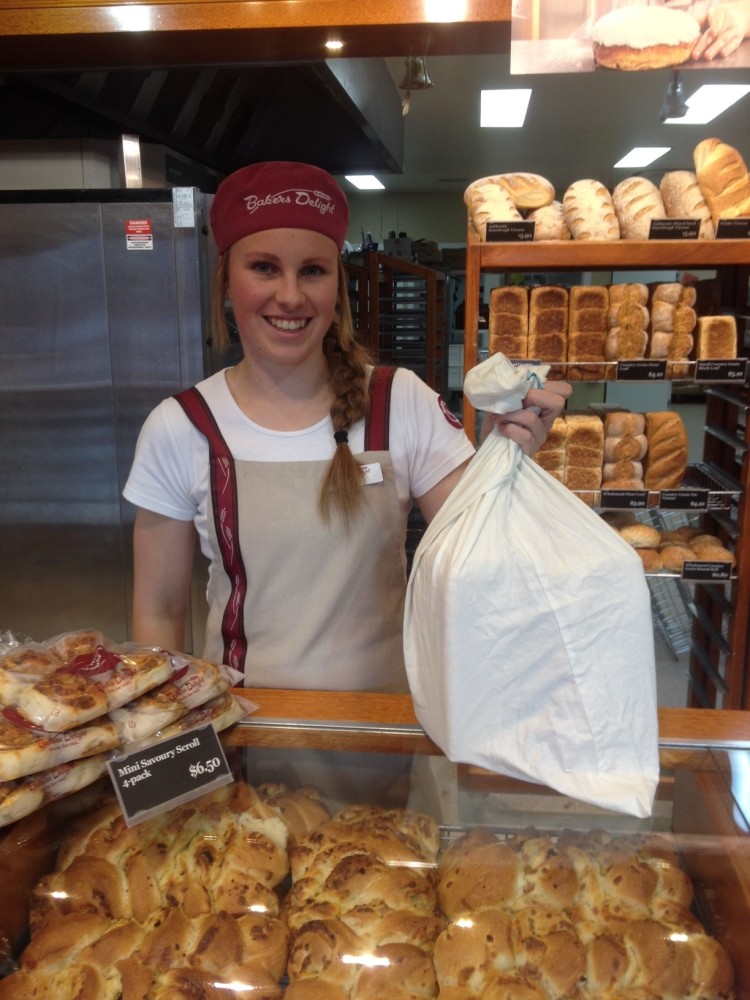
I decided to buy our bread direct from the baker. Initially I used a pillowcase because that’s all I had and I don’t like buying new things if I don’t have to. I could fit four loaves in each pillowcase. To freeze, I put the pillowcase of bread straight into the freezer but it was a bit awkward to manage so I made individual bread bags. The assistants at all the bakeries I go to love these because they can slice the bread and slide it straight into the cloth bag in exactly the same way as they would with a plastic bag. It is also easier to manage the bread from the freezer to the bread tin at home.

I’ve read a lot of different advice about the best way to store bread but I haven’t noticed any difference at all between my bread stored at room temperature or frozen in a cloth bag and the store bought plastic wrapped bread. The longest a loaf stays in the freezer at our house is two weeks.
When I first started doing this the bakers were so surprised, telling me they have never had anyone collect their bread in a cloth bag before. Now they are telling me that others are bringing in pillowcases and cloth bags, and I am also getting really positive comments about them from other customers. Go ahead and give it a try. The more of us that do it the more normal it becomes, just like the green bags in the supermarkets. If you need a little more encouragement I filmed myself at the baker, which you can watch below.
Make your own bread bags
If you are new to sewing (like me) but want to have a go at making your own bread bags, check out how I did it below.
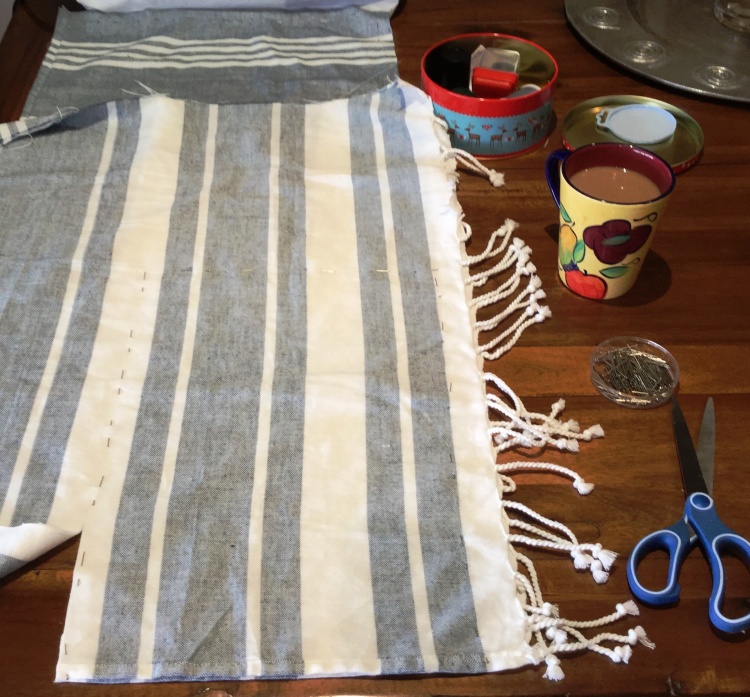
I had this beach towel – that is actually more like a scarf or shawl – that I had never used. I thought the material and pattern would work well for bread bags.
Make sure your material has been pre-shrunk and cut out rectangles the size of 13 inches by 17 inches. Stitch them together inside out. Don’t forget to hem your open ends if your material doesn’t already have a hem you can use.
To give the bag a square bottom, manipulate the bag so that the seam runs vertically down the middle. Fold the ends so that they form a triangle.
Next I fold each side of the triangle back up so that the point meets the bottom of the triangle.
Mark the fold with pins, stitch across the fold, and then trim the corner off. Repeat on the other side. You will be left with a square bottom once you turn the bag right way out.
Next sew on a scrap piece of material or cord to tie the bag securely. I did not use a drawstring to close the bag because it is not as airtight. Your bag is now complete.

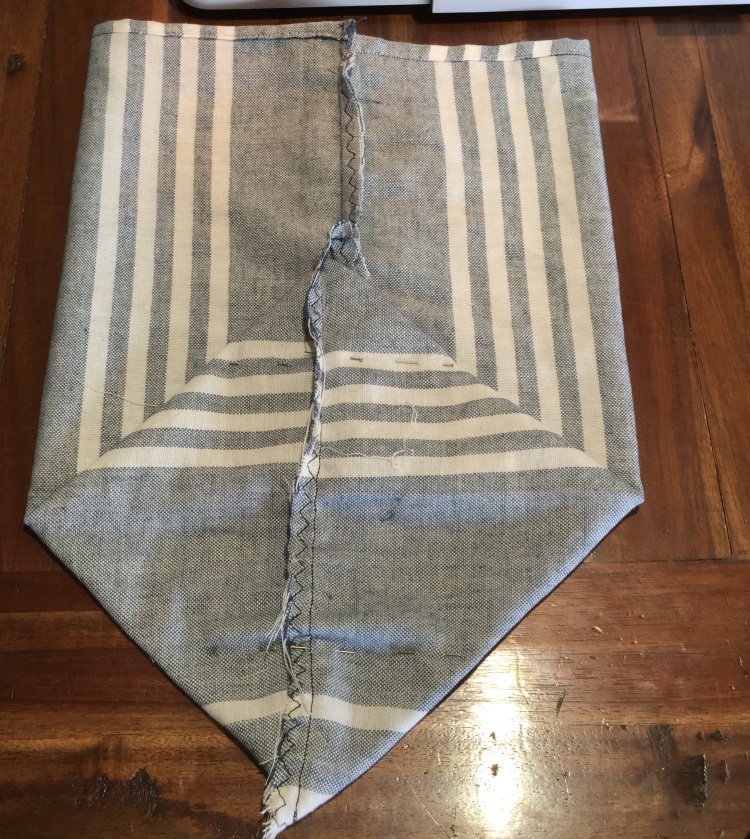
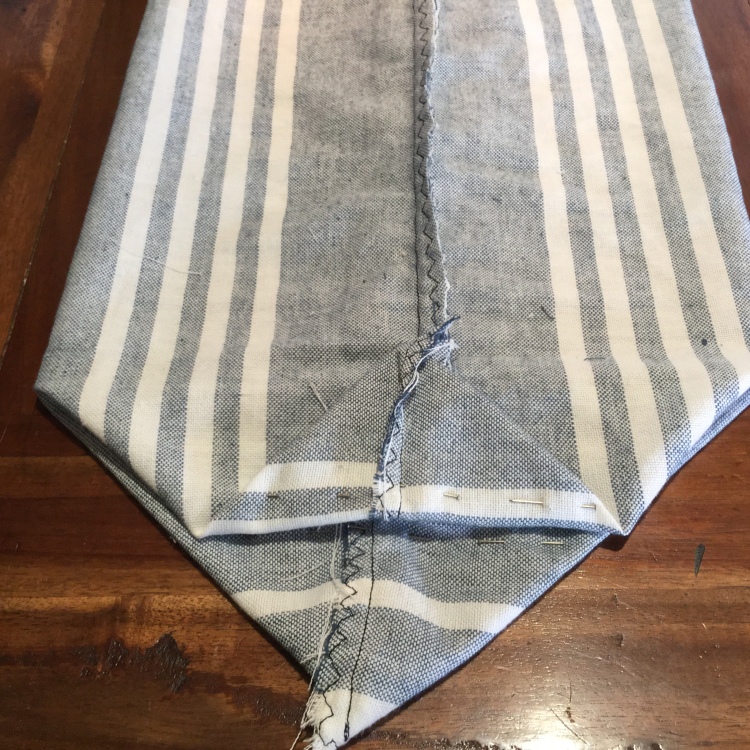
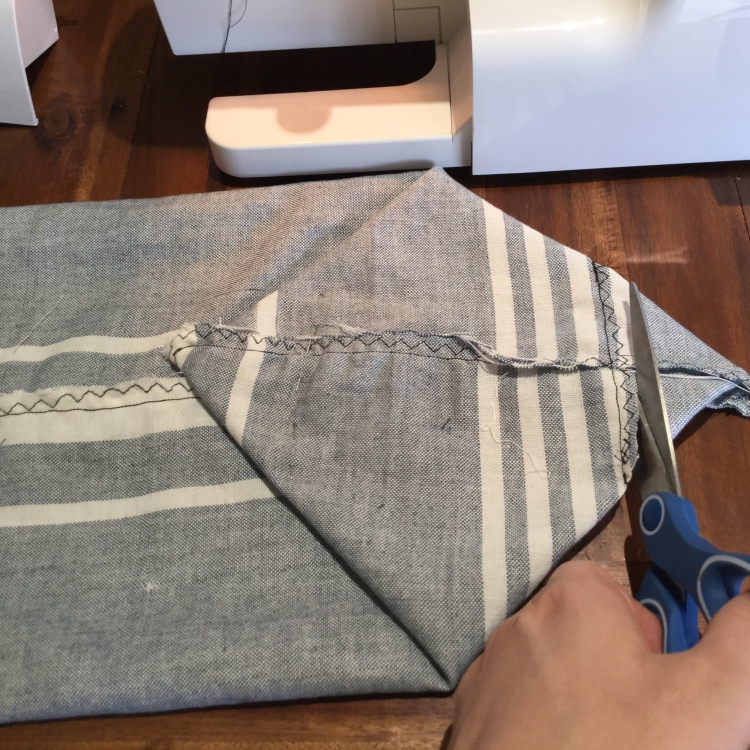
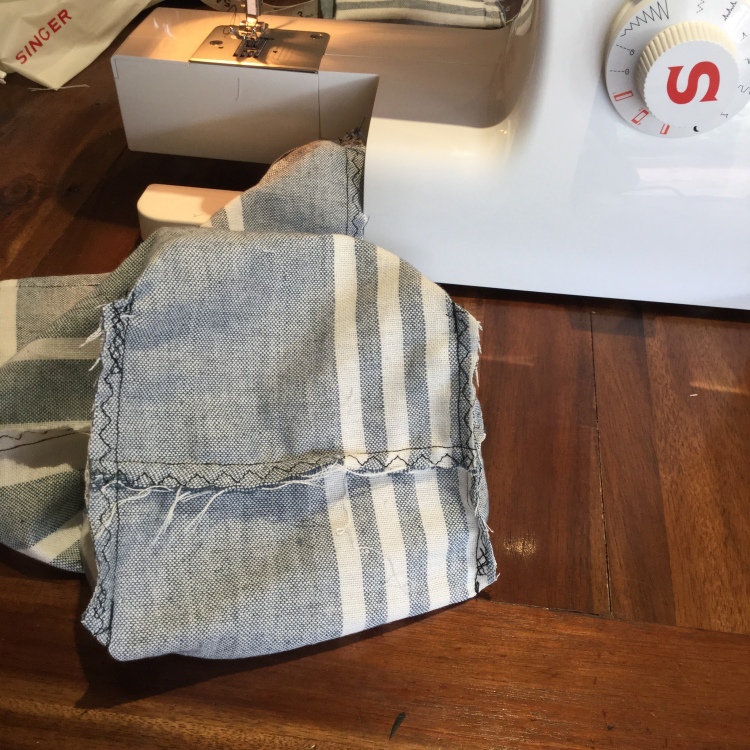
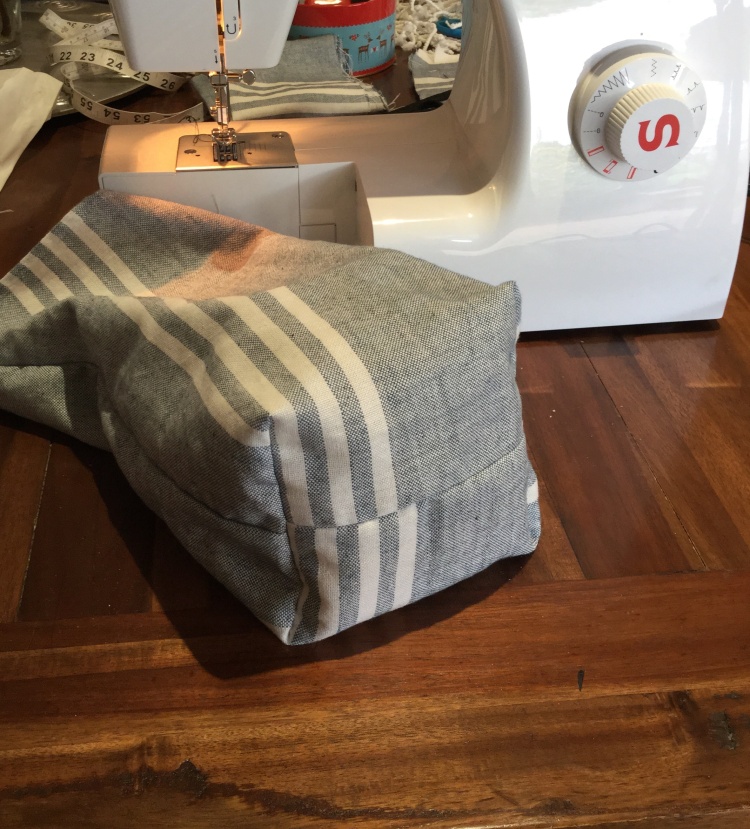



So cool to see you doing something as simple as making your own bread bag as an initiative to reduce waste! It’s pretty crazy that those paper bags still has hidden plastic! We’re doing a bread week in terms of reducing food waste behaviours on our blog, and I think it is definitely impactful to be initially conscious of the packaging that your bread comes from!
x
LikeLiked by 1 person
Thanks Angela. It is impactful; as a family of four we go through a lot of bread and I really notice the difference. This change has been one of the easiest! And every time I use them with different staff, they love them. They always say “what a great idea” and I can see them thinking about it.
LikeLiked by 1 person
Yeast comes in reusable glass jars.
LikeLike
What a a really really great idea! We use big cottonbags and buy the loafs uncut, because the bags are too big. But this is really wonderful! I will make my own bags now. Thanks so much for sharing!
LikeLiked by 1 person
Thank you! I was doing the same thing but still getting it cut, however that seemed to make the bakers nervous so I decided to make the bags so they could still do as they always did, now everyone is happy :-).
LikeLike
It’s really wonderful that we’ve got Tammy from gippsland unwrapped and that people are actually thinking about the planet that we are leaving our children and grand – children. Plastics are poisoning the earth and we need to do something about it.
Kind Regards to you Tammy and God Bless from Sandra Horton. A 68 year old from Geelong Victoria.
LikeLiked by 1 person
Can i ask which bakers delight you go to? Wondering if I’m going to freak out my local one. Warragul?
LikeLiked by 1 person
Hi Kirsten, They are very familiar with me at Warragul and Leongatha. I also regularly go to the Baker on Smith street in Warragul. They all love the bags.
LikeLike
how do u prevent the bread from getting ice on it in the freezer ,does the crust go really hard when it thaws out thanks
LikeLiked by 1 person
I haven’t found this to be a problem. I read all sorts of stuff about storing bread before just deciding to have ago in cloth and it was fine. The crust is a little harder after a while, but still edible in a sandwich. Maybe have a go and if it doesn’t work out use the bread to make crumbs.
LikeLike
I dont know where your BD staff have been hiding but the store used to give away calico tote and drawstring bags for their bread. I still have three that are coping admiably with the wear.
LikeLiked by 1 person
That’s great! My store is in Warragul but I have been to others and they are always amazed by my cloth bags. I always get asked if I have considered selling them, but that’s not my thing. I want people to make them themselves from scrap fabric.
LikeLike
What a great idea. We go thru a loaf a bread a day in our house. I usually by in bulk and freeze them. I will have to make some of those bags. We actually reuse all our bread plastic bags for lunches and for storing and freezing other things in. I know we are trying to get rid of plastic that is why we reuse all of our until they can not be used any more. But I love this idea and will be starting to do this.
LikeLiked by 1 person
I think that’s a great way to reuse plastic bread bags. I just had a thought that you could reuse some of those bags to go over the cloth bags in the freezer and get even longer storage life if you needed it. Let me know if you do any experimenting.
LikeLike
No worries. I’ll just have to brush up on some sewing skills and get some bags made up first. Then I will try it out.
LikeLiked by 1 person
Where I live you can buy fresh yeast in big paper wrapped blocks at the wholesaler. I cut it into cubes and freeze them in a container. Just make sure you defrost a cube in advance! You can’t microwave yeast. The paper goes in the compost. Not ideal, but better than dried yeast and it tastes so much better.
LikeLiked by 1 person
Thanks. I’ll be in the lookout for this option now 👍🏻. I’ve never used fresh yeast before.
LikeLike
I buy my fresh yeast at the Deli. It’s cut up by the Deli staff into little blocks for around $1 – $1.20 per little block. It’s enough for about 4 loaves. It really does make the bread taste wonderful. I also have dried yeast in the freezer just in case I can’t get to the Deli.
LikeLiked by 1 person
I learned how to keep a sourdough starter alive. I keep it in a mason jar in the fridge. No need to buy yeast at all. And the strain I have isn’t as sour as what most people think as long as I take care of it right (feed it). The flavor is fine for sandwiches and adding potatoe starch to the dough softens the crumb texture of my fresh ground whole wheat bread.
LikeLiked by 1 person
Or you can make sourdough starter and keep a jar in your fridge and skip the yeast as the starter does the same thing
LikeLiked by 1 person
I also buy yeast in glass. Dried of course.
LikeLiked by 1 person
That’s handy!
LikeLike
Is the bread okay in the cloth bag in the freezer? I find bread tends to dry out in the freezer pretty quickly.
LikeLike
Yep, I really don’t have any issues but it hasn’t been in the freezer for longer than 3 weeks, usually only two. Why not give it a go with one loaf and see how it goes. 🙂
LikeLike
Doesn’t the bread dry out quickly?
LikeLike
No I don’t have any issues. 🙂
LikeLike
Next to the foil packets of yeast there’s usually a small glass jar of yeast you can buy too. Every grocery store I’ve been to has it. If your grocer doesn’t carry it, you can request it. The brand is red star.
LikeLiked by 1 person
Thanks Karlie, I’ll take another look next time I’m in a big town with a bigger supermarket. 🙂
LikeLike
Hi, it´s funny how thigs come back after some time.
I was born un 1964 and plastic made it´s debut in my country (uruguay) sometime in the seventies.. so I remember going to the bakery (being 8 by myself 2 blocks form the house, normal occurrence back then) with a bread bag, Every house had one made of cotton and usually with the enbroidered image of a bagette on it.
Supermarket bags were just brow paper, and cookies came in big tins to the grocery and they sold you the cuantity you wanted weighting it on a scale and wrapping it in brown paper….
Nothing was disposable…. it was simpler and healthier too.
LikeLiked by 1 person
Yeast also comes in glass jars!
LikeLiked by 1 person
Ive seen yeast in glass jars. Where would I find it? 😊
LikeLike
I’m not sure where you are (I’m in Kansas City, Missouri, USA), but I buy yeast in glass jars with a metal lid. I bake A LOT of bread though. Also, the bulk four at our Costco store doesn’t have the plastic between the paper. If I have to buy bread, my local Hy-vee grocery store has waxed paper bags if you don’t want plastic, but they don’t bat an eye when I whip out my bread bags either.
LikeLiked by 1 person
Ah okay, thanks. I’m in a country town in Australia. 😊
LikeLike
I too am really trying to shed plastic, it is really hard as everything seems to have plastic around it in one form or another. I make homemade bread slice it & place pieces of baking paper between the slices to make it easier to take out a couple of slices at a time. I put the loaf in a long paper bag I recycle from the chemist. I have also saved the paper bag from a bottle of wine purchase too. I then wrap in a t.towel but I will make some bags now.
I have a bread maker but I only use it to mix the dough & do the first rise, I then take it out of the machine give it a knead & shape, leave to rise again & bake. It is so much better than letting the machine cook it.
LikeLiked by 1 person
Hi Coral, have you had a chance to make any bags yet? Just wondering how you got on.
LikeLike
You young girls are smart!!! I’m 82 and still like to make bread as well and all other goodies. My gramma used to take a 5# bag of flour, 1 cake of yeast,some melted lard, water. She made 5 loaves of bread. At Christmas she would take coffee cans and use them as tins. They looked like mushrooms. They were wrapped in newspaper and delivered to the whole neighborhood.Ah the memories.
LikeLiked by 1 person
Thanks for sharing your memories Julia. 🙂
LikeLike
What a great and easy idea! I’ll definitely whip up a few of these.
LikeLiked by 1 person
Fantastic Amanda!
LikeLike
I think I’m really spoiled. We can buy active yeast in glass jars with metal lids here. I saved the last one and just get yeast from our local bulk store and refill the jar. Like I said….spoiled!
LikeLiked by 1 person
Yes, spoiled! lol 😊
LikeLike
Does the bread in the freezer pick up any freezer taste?
LikeLike
Definitely not.
LikeLike
I just used your instructions to make a bread bag out of a scarf my sister accidentally picked up (caught up with other clothes) at a clothes-swap party. Thank you so much! The steps were clear and easy to follow and the bag fits a loaf of bread just right. I love the square bottom and I’m looking forward to using my new bread bags (the scarf will make three almost exactly to your dimensions) next time I’m at Brumby’s/Baker’s Delight. Thank you!
LikeLiked by 1 person
Oh that’s great to hear Bella, thanks for sharing! 🙂
LikeLike
Thanks for this post! Love it!
Question: for the corners on the bottom of the bag, how much of a triangle do you cut off? I would like to make some but don’t want to mess it up 😉 Thanks!
LikeLiked by 1 person
It’s not a lot, but if you are worried, just do a small amount and then check how the bag sits. If it’s not enough, sew the line in further and see how that goes. 🙂
LikeLike
Hi,
I LOVE THIS! I’ve been cracking my head how to replace those plastics!
Question, my country is super humid. I usually put my bread into the fridge the day itself or next day with the plastic that came with it.
Is it ok to put a 100% linen bread bag into the fridge or freezer?
Thank you!
So gonna make some!
LikeLiked by 1 person
Hi Ruby, It’s my understanding that storing bread in the fridge is really bad for it and makes it go off quicker. Is it common practice for people to put bread in the fridge where you are? Freezer is okay and bench or pantry. Let me know if you have other questions. 🙂 Tammy
LikeLike
Hi Tammy, thank you for your reply. Really?? I’ve been doing that for years! We usually finish up the bread in 3 days and it doesn’t mold. We always freeze the other half and when we want it, we will take it out from freezer, defrost in fridge and eat it for 3 days.
I have one more question. Can you please give me the measurement of your bread bag when it is all sewn together?
Thank you
LikeLike
Yeah, a quick bit of googling reveals lots of articles like this https://www.theguardian.com/food/shortcuts/2020/mar/05/from-ketchup-to-pineapples-the-food-that-should-never-be-kept-in-a-fridge 🙂 I’ll grab the measurements for you when I find something to measure them with, my tape seems to have gone missing.
LikeLike
Hi!
Thank you for this post. Today I just made my very first bread bag and I love it!
Greetings from Budapest!
LikeLiked by 1 person
Hi, thank you for the tutorial! I was wondering how you clean the bags and whether the fabric itself freezes?
LikeLike
I just put them in the washing machine with a regular load to clean them, then hang on the line to dry. The cloth doesn’t really freeze. 🙂
LikeLike
This would be cool as a gift with homemade bread!
LikeLiked by 1 person
Great idea and guide! I made 4 of them plus cotton wraps for double-layering in the freezer while I was waiting for my bread to rise, bake, and cool.
I haven’t pulled any out of the freezer yet but they work fabulously on the countertop. We just polished off the first of the 4 loves today. 5 days later and the inner loaf was still nice and soft, with a crispy crust. Past day 3, probably not ideal for sandwiches but it made for tasty toast. The heel was a bit dry but that just got chopped up and chucked in the to-be-croutons bin in the freezer.
All in all, much better than plastic bags for a whole host of reasons. Thanks so much for the guide and pattern (and for making it a low waste pattern to boot!).
LikeLiked by 1 person
Great feedback, Kirsten, that I’m sure others will appreciate too. Thank you
LikeLike